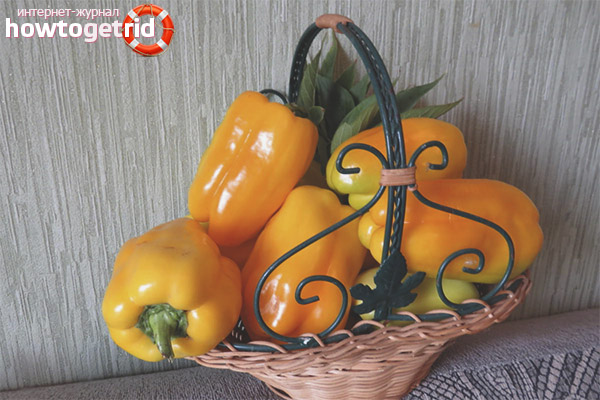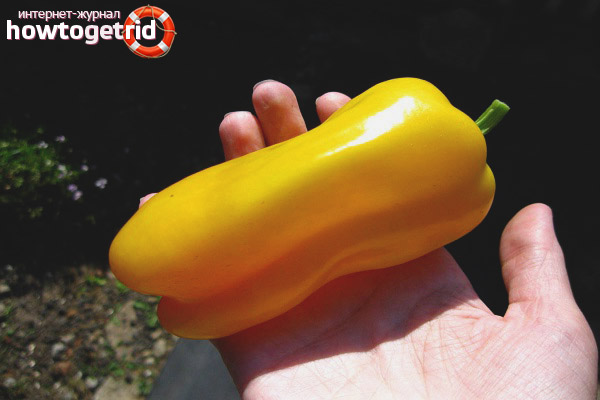The content of the article
The undoubted advantage of the hybrid orange pepper Orange lion is resistance to most diseases and pests. Pepper can be used for stuffing, canning and eat fresh. The disadvantage of the culture can be considered not too much productivity.
Grade description
The hybrid belongs to the early varieties with a sufficiently high yield for various diseases. Harvest, as a rule, can be harvested in 100 -105 days from the time of planting seedlings in open ground. With proper care and favorable climatic conditions, up to six kilograms of product can be collected from one square meter. The ripe fruit reaches a mass of 200 grams, has a pyramidal shape. The flesh of the pepper is quite fleshy, the wall thickness of about eight millimeters. This variety is ideal for fresh consumption as well as for baking and canning.
In height, the Orange Lion reaches one meter. The bush has a dark green leafy cover.
Growing
After this, it is worthwhile to carry out the hardening procedure in an unconcentrated potassium permanganate solution. This will help to avoid the emergence of further fungal diseases. After the seeds need to be placed on wet gauze and left to swell.
Planting seeds of bell pepper is recommended in small peat pots. Large containers for seedlings are undesirable, since the pepper root system is slowly developing.
Attention! When planting, do not deepen the seeds too deeply, as this can significantly slow down their germination.
If the pepper will be grown in the open field, then about two weeks before planting the seedlings should start to be taken out to the street for hardening, for a couple of hours.
When four leaves appear on the seedlings, it can be planted in open ground. This procedure is best performed in early May, when the temperature at night does not drop below thirteen degrees.
When landing in the ground, choose the most protected places from the wind. Otherwise, this crop will feel uncomfortable, which may affect crop yields.
Before planting pepper, it is recommended to prepare the soil in advance. To do this, about one square meter of the plot contribute forty grams of nitrate. Also, if desired, for final preparation, the soil can be sprinkled with copper sulfate.
Care
An important component of pepper care is watering it. This variety does not like drought, but also does not tolerate excess water, for this reason it is necessary to ensure that the soil does not dry out, but do not overdo it. Excess water can lead to fungal diseases, and also to decay of the plant.
- Watering is carried out directly under the root, otherwise there is a risk of sunburn on young foliage.
- When planting in open ground, remember that on one square meter should not be more than three plants.
- Do not forget about the stepsoning procedure. It will help to direct all energy to the development of the fruit, and not to the vegetative mass. But for all its benefits, it is worth remembering that you can’t remove more than three shoots at a time, and the procedure itself should be done no more than once every ten days.
- If you are going to transport pepper, then harvesting should be carried out while it is in a state of technical maturity.
- Noble soils, chernozems, sandy soils are ideally suited for this culture. If you grow a variety on poor soil, you should regularly fertilize the soil.
- For irrigation use only warm, settled water. If desired, a little ash can be added to the water. During the growing season, the plant needs more active and plentiful watering.
- If the soil is fertile, then three-time fertilizing will be enough, otherwise feeding should be done much more often. If the pepper will be grown in a greenhouse, bring plain garden soil.
- In plants with a lack of potassium leaves begin to curl, which can affect its development. But when adding potassium, you must be extremely careful, as this culture will not tolerate its excess.
- If the plant feels a lack of nitrogen, then its leaf cover gradually becomes dull and smaller.
- In the event that phosphorus is lacking, the underside of the leaves turns purple, and the leaves themselves begin to stretch upward. With a lack of magnesium, dropping of ovaries and flowers is possible.
The plant can be grown quite successfully both in open and in closed ground. But to achieve the maximum yield, it is better to use the greenhouse conditions.
Video: how often and how much to water pepper?











Submit